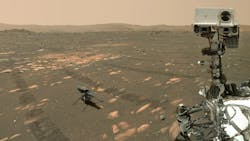My favorite robotics newsletter hit my inbox a few days ago and it was full of thought-provoking material. I was looking for any articles about robots used for autonomous inspections, so I did a speed-read of its contents. There were a couple of possibilities, but there was an article displaying NASA’s logo that caught my attention.
NASA was excited about the ongoing adventures of NASA’s Mars rover Perseverance and the robot helicopter Ingenuity. Ingenuity had set a milestone. I admit, it was a bit of a side trip, but the graphics demanded a closer look. This isn’t the first time I have included this exploring duo in my writings. These robots represent cutting-edge applications in a trending technology that is having a massive impact on the power grid.
When NASA launched the mission, no one was sure a helicopter would be able to fly in the thin Martian atmosphere, but that didn’t stop the NASA team. The science was sound, and the math was solid. In April of 2021, Ingenuity took its first flight proving the scientists and engineers were correct.
Exceeding Expectations
Powered, controlled flight on Mars was possible. Ingenuity was designed to have five flights, but when April of 2022 rolled around, Ingenuity was still flying and had completed flight #28. The little chopper had proven its adaptability. Ingenuity took on the role of being Perseverance’s scout as it roved across the Martian landscape.
The robotic newsletter opened with a headline proclaiming Ingenuity had flown its 50th flight in April, 2023! Ingenuity had broken all records with over 89 minutes of flight and had covered more than 7.1 miles (11.6 kilometers). In other words, every time Ingenuity flies, it goes where no one has gone before, providing a viewpoint never seen before. It also means that Ingenuity’s scouting effort was becoming more challenging.
The intrepid duo has moved from the flat landing site to a terrain of the ancient river delta in the Jezero crater with ravines and many elevation changes. NASA’s engineers had to change the way Ingenuity operated. Ingenuity needed input in the decision making if it was to continue as Perseverance’s scout.
Simply put, Ingenuity’s artificial intelligence (AI)-driven software needed more awareness. An upgrade was required, and it was extremely demanding. As I read about the technological challenges involved with keeping robotic duo operating together, it made the utilization of autonomous inspection robotics on the power grids sound pretty routine.
Boring is a Good Thing
When innovative technology starts sounding routine or boring, it’s a sign that the technology has advanced to the point where people are no longer in awe of it. We are comfortable with it. It’s another way of saying the technology is maturing and more user-friendly. Mainly, the technology is moving further into the mainstream, and becoming commonplace.
Manufacturers are offering systems designed specifically for the needs of industrial segments like the power delivery system. Boston Dynamics’s Spot is an agile quadruped autonomous robot that is being used by utilities such as National Grid, TALEN Energy, Energie NB Power, and others for autonomous inspection tasks.
Siemens Energy, Elia Group, and Nemo Link with Foss Robotics are co-developing an inspection robot to go inside HVDC (high-voltage direct current) converter halls during operation. Being able to inspect energized valve halls reduces outages and improves personnel safety.
There are also scenarios here on Earth similar to those experienced by Ingenuity and Perseverance on Mars. Sometimes the inspection robot needs more information than can be provided by a remote operator. To perform its mission the robot really requires the freedom to make decisions based on conditions.
ANYbotics has an autonomous robot called ANYmal. ANYmal uses an augmented reality to guide its decisions even if there is an interruption in its GPS (global positing system) or a loss of internet access. Vattenfall, an integrated energy company, and Siemens Energy are testing ANYmal at the Marzahn power station. ANYmal takes advantage of advancements in real-time algorithms, AI, and cloud computing to make this possible.
A quick check showed the global market for autonomous inspection robotics is projected to grow by about 8.4% CAGR (compound annual growth rate) in 2023 with spending expected to reach US$4.2 billion by 2028. It’s hard to imagine how NASA’s Martian AI-driven decision making autonomy will improve our robotics, but it will. It may sound like science fiction, but the technologies exist to make it happen. I can’t wait to see what’s next!
About the Author
Gene Wolf
Technical Editor
Gene Wolf has been designing and building substations and other high technology facilities for over 32 years. He received his BSEE from Wichita State University. He received his MSEE from New Mexico State University. He is a registered professional engineer in the states of California and New Mexico. He started his career as a substation engineer for Kansas Gas and Electric, retired as the Principal Engineer of Stations for Public Service Company of New Mexico recently, and founded Lone Wolf Engineering, LLC an engineering consulting company.
Gene is widely recognized as a technical leader in the electric power industry. Gene is a fellow of the IEEE. He is the former Chairman of the IEEE PES T&D Committee. He has held the position of the Chairman of the HVDC & FACTS Subcommittee and membership in many T&D working groups. Gene is also active in renewable energy. He sponsored the formation of the “Integration of Renewable Energy into the Transmission & Distribution Grids” subcommittee and the “Intelligent Grid Transmission and Distribution” subcommittee within the Transmission and Distribution committee.
